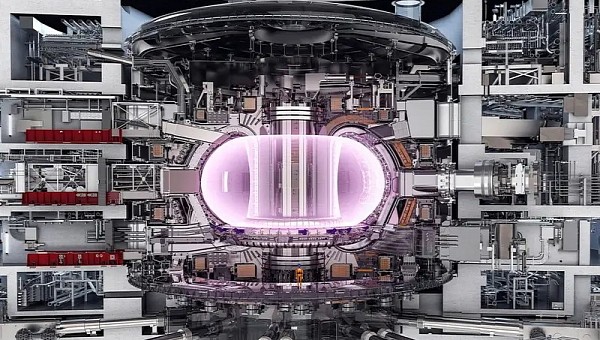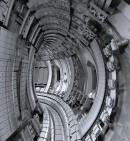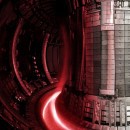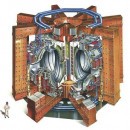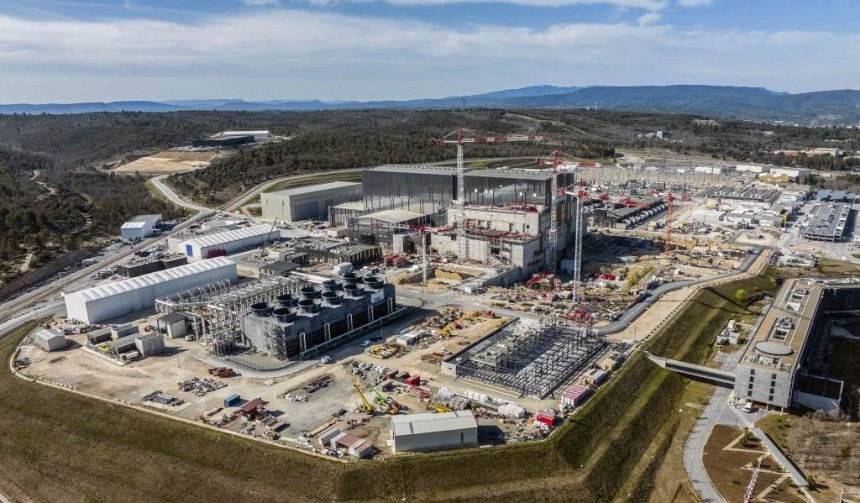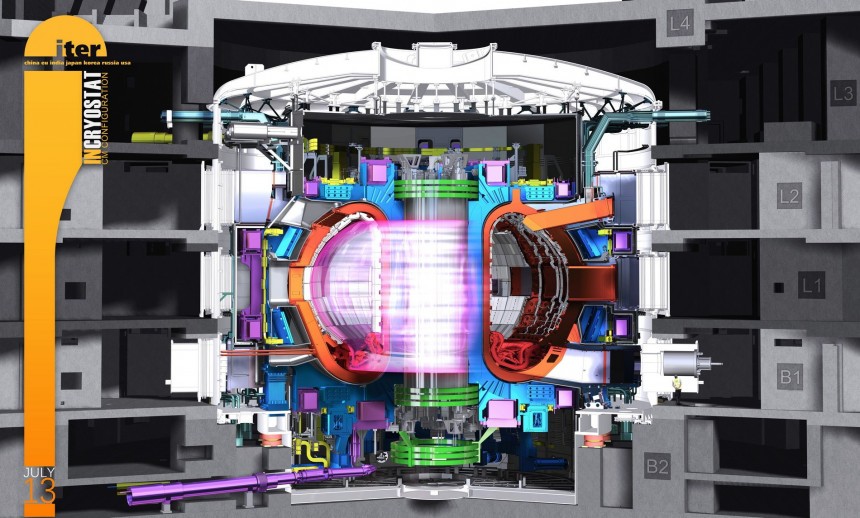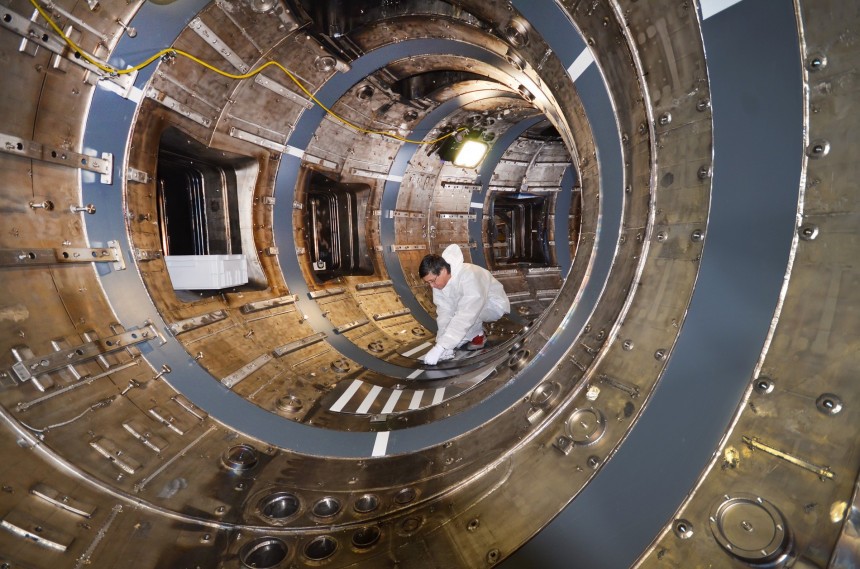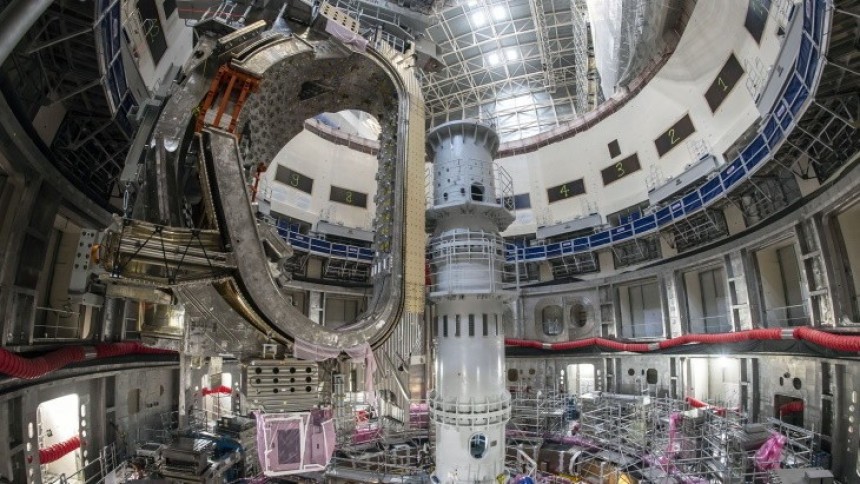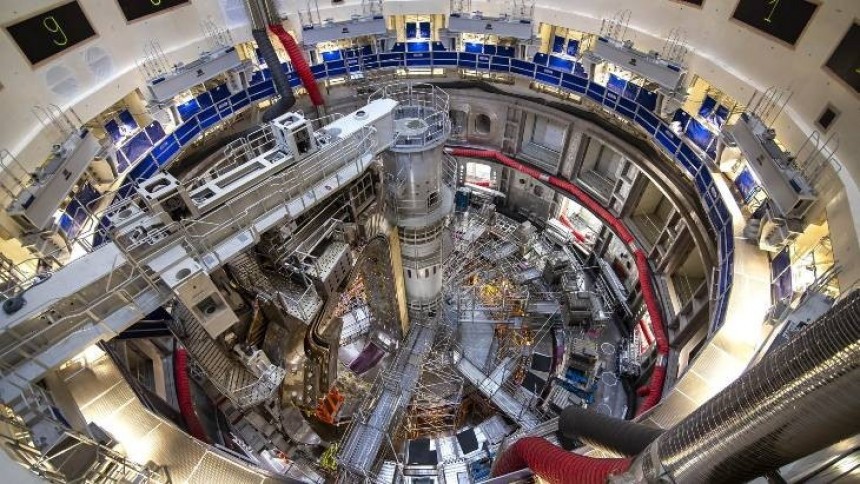The world is in a constant state of chaos and everyone is up in arms at each other. At least, that's what you're liable to believe if you watch too much of the news. But the spirit of international cooperation is still strong, whether or not its more positive benefits get lost in the news shuffle. Want proof positive? Look no further than ITER. A nuclear fusion research facility where even the U.S., Russia, and China all get along.
And why wouldn't they? Every engineer involved with the International Thermonuclear Experimental Reactor (ITER), no matter where in the world they were born, is working towards the same thing. Technologically viable and economically sustainable nuclear fusion is the name of the game. Something that spectacular is only possible when everyone is on the same team.
Headquartered in Saint-Paul-lès-Durance in Southern France, the population of this sleepy French village hasn't seen its population rise past the triple digits since the late 1700s. A great many people who do live there work in some capacity for the Cadarache Research Center responsible for ITER's construction. Being the world's largest tokamak-class fusion reactor when it's complete, this is no small task.
In truth, it took the world's two preeminent global superpowers coming together for a shared purpose of deciphering the mechanisms that power every star in the universe. The first whisperings that the U.S., Soviet, and the world at large were looking to collaborate on a nuclear fusion project began in 1978.
At the time, talks between the Soviets, Americans, Japan, and a handful of nations in the European Atomic Energy Commission began with a goal to create the world-leading tokamak-class reactor. One that'd be the envy of any science program. Though initial proposals largely fell on deaf ears, things changed in March 1985 with the rise of Mikhail Gorbachev to the General Secretary of the Communist Party.
At that year's Geneva Summit between the Soviets and the U.S., Gorbachev sat down with then-U.S. President Ronald Reagan. During their conversation, Gorbachev discussed with Reagan a conversation he had with French President François Mitterrand the month before. Wherein the two world leaders discussed the possibility of a then-unheard-of scientific initiative.
Dubbed the International Tokamak Reactor, or INTOR, at first, the project proposal with like an International Space Station-sized investment right in the picturesque South of France instead of Low Earth Orbit. What was called for was nothing short of the largest fusion reactor of any variety ever constructed. A leviathan of a machine capable, in theory, of generating upwards of 500 MW of capturable electrical power all by itself.
Tokamak-style fusion reactors were nothing new, even in the mid-1980s. As far back as 1934, the first successful attempt at human-produced nuclear fusion was completed by Paul Harteck, Earnest Rutherford, and Mark Oliphant using a rudimentary partical accelerator similar in principle to a modern tokamak.
On the other hand, the distinct donut-shaped tokamak fusion reactor was one of the shining beacons of Soviet technological breakthroughs in the years just preceding the Soviet Space Program. Inspired by a letter from Soviet scientist Oleg Lavrentiev, engineers Andrei Sakharov and Igor Tamm constructed the first working prototype in the 1950s. The real challenging aspect of a tokamak's operation is producing as much power or more out of a nuclear reaction as was required to induce the reaction in the first place.
This phenomenon is called scientific-breakeven. Though this was achieved for the first time, not at ITER but in a lab in California back in 2022, the focus of ITER development has shifted from being the first to breakeven to simply being the best at making it happen. It would take a further decade from the mid-1990s for the particulars of the ITER complex to be formally agreed upon.
In the end, E.U. member nations of the period, like Switzerland and the U.K., among others, were joined by Russia, China, Japan, South Korea, Canada, Thailand, India, and the U.S. in the development of the ITER project. After an opening ceremony hosted by the French President Jacques Chirac to celebrate ITER's founding, the facility broke ground in Cadarache in March of the following year.
By 2013, work had begun on the construction of ITER's Tokamak complex. Three years later, Australia and Kazakhstan were introduced as non-member cooperators to the project in 2016 and 2017, respectively. As far as construction projects went, ITER's was like the world's most elaborate puzzle. With over one million components consisting of upwards of ten million individual parts, the ITER Tokamak makes the Saturn V mega-rocket seem like a LEGO toy.
Like any nuclear reactor, ITER needs fuel. The fuel scientists chose to power ITER's Tokamak when it's completed will be a special blend of deuterium, which is no big deal to find in abundance in nature, and also tritium. If you weren't aware, there are less than 50 kilograms of tritium known to exist in all the world's stockpiles. The basic operating principle of ITER consists of injecting both deuterium and tritium into the reactor's fusion chamber, which has been evacuated of all the air inside to form a near complete vacuum.
At this point, a series of electromagnetic coils arranged in sequence around the fusion chamber and insulated by layers of barrier metal allows the atoms and sub-atomic particles inside the nuclear fuel to become ionized. This forms a bright, distinct ring of ionized plasma around the inside of the reactor. Until the National Ignition Facility in California achieved burning plasma using an entirely different type of laser-fusion reactor, this had never been achieved before.
Confining this plasma around the center of the fusion chamber while not allowing any of the superheated substance to interact with the walls of the reactor is perhaps the most important safety precaution of the whole affair. As the reaction temperature increases, the kinetic energy of the ionized particles inside the plasma smashing into one another is theoretically powerful enough to break electromagnetic forces keeping atoms apart, allowing them to fuse.
Such a fusion reaction is the foundation of how stars form and operate in the vastness of space. But in the case of a tritium-deuterium fusion, the results should form atoms of helium-4 isotope plus a spare neutron. In between the walls of the reactor, scientists plan to place a "breeding blanket" consisting of lithium metal that's slated to be bombarded with ionized neutrons to create new supplies of tritium fuel.
Said breeder blanket is surrounded by a particular alkaline earth metal called beryllium, which further manipulates the neutrons inside the breeding blanket into chemically reacting with lithium to create the tritium which scientists desire. Though it may look and sound like alchemy to most folks, it's just another way nuclear physics takes something considered witchcraft and makes it a reality.
At the present day, the only practical means of gathering tritium is as a byproduct of, ironically, nuclear fission reactors, usually from light-water or heavy-water moderated reactors like the CANDU class operating in Canada, India, and Romania. This novel approach to tritium breeding is theorized to be even more efficient at restocking global supplies of tritium. A supply which, mind you, decays into plain-jane helium after around 12 years if it's not used quickly enough.
If all goes to plan, a cooling chamber surrounding the layers of magnets around the fusion core will be able to convert the kinetic energy of the reaction into steam via high-pressure water traveling through cooling channels to drive turbines in the same manner as a fission reactor. As of late 2023, the ITER complex hopes to test its first plasma sometime in 2025, with electricity-generating operations commencing soon afterward.
Does this mean by this time, ten years from now, that ITER will be regularly achieving full fusion? Well, the answer is nobody has an earthly clue. First plasma was already due to begin sometime this year, but delays in construction have things pushed back to that 2025 date.
As veterans of four back-to-back Artemis I launch scrubs, we know you can't rush perfection. But when the grand prize is a new golden age for humanity with near limitless, carbon-free energy, you'll forgive us for being a little antsy. Best of luck to everyone involved with the ITER project. You all have us rooting for you.
Check back soon for more nuclear energy news right here on autoevolution.
Headquartered in Saint-Paul-lès-Durance in Southern France, the population of this sleepy French village hasn't seen its population rise past the triple digits since the late 1700s. A great many people who do live there work in some capacity for the Cadarache Research Center responsible for ITER's construction. Being the world's largest tokamak-class fusion reactor when it's complete, this is no small task.
In truth, it took the world's two preeminent global superpowers coming together for a shared purpose of deciphering the mechanisms that power every star in the universe. The first whisperings that the U.S., Soviet, and the world at large were looking to collaborate on a nuclear fusion project began in 1978.
At the time, talks between the Soviets, Americans, Japan, and a handful of nations in the European Atomic Energy Commission began with a goal to create the world-leading tokamak-class reactor. One that'd be the envy of any science program. Though initial proposals largely fell on deaf ears, things changed in March 1985 with the rise of Mikhail Gorbachev to the General Secretary of the Communist Party.
Dubbed the International Tokamak Reactor, or INTOR, at first, the project proposal with like an International Space Station-sized investment right in the picturesque South of France instead of Low Earth Orbit. What was called for was nothing short of the largest fusion reactor of any variety ever constructed. A leviathan of a machine capable, in theory, of generating upwards of 500 MW of capturable electrical power all by itself.
Tokamak-style fusion reactors were nothing new, even in the mid-1980s. As far back as 1934, the first successful attempt at human-produced nuclear fusion was completed by Paul Harteck, Earnest Rutherford, and Mark Oliphant using a rudimentary partical accelerator similar in principle to a modern tokamak.
On the other hand, the distinct donut-shaped tokamak fusion reactor was one of the shining beacons of Soviet technological breakthroughs in the years just preceding the Soviet Space Program. Inspired by a letter from Soviet scientist Oleg Lavrentiev, engineers Andrei Sakharov and Igor Tamm constructed the first working prototype in the 1950s. The real challenging aspect of a tokamak's operation is producing as much power or more out of a nuclear reaction as was required to induce the reaction in the first place.
In the end, E.U. member nations of the period, like Switzerland and the U.K., among others, were joined by Russia, China, Japan, South Korea, Canada, Thailand, India, and the U.S. in the development of the ITER project. After an opening ceremony hosted by the French President Jacques Chirac to celebrate ITER's founding, the facility broke ground in Cadarache in March of the following year.
By 2013, work had begun on the construction of ITER's Tokamak complex. Three years later, Australia and Kazakhstan were introduced as non-member cooperators to the project in 2016 and 2017, respectively. As far as construction projects went, ITER's was like the world's most elaborate puzzle. With over one million components consisting of upwards of ten million individual parts, the ITER Tokamak makes the Saturn V mega-rocket seem like a LEGO toy.
Like any nuclear reactor, ITER needs fuel. The fuel scientists chose to power ITER's Tokamak when it's completed will be a special blend of deuterium, which is no big deal to find in abundance in nature, and also tritium. If you weren't aware, there are less than 50 kilograms of tritium known to exist in all the world's stockpiles. The basic operating principle of ITER consists of injecting both deuterium and tritium into the reactor's fusion chamber, which has been evacuated of all the air inside to form a near complete vacuum.
Confining this plasma around the center of the fusion chamber while not allowing any of the superheated substance to interact with the walls of the reactor is perhaps the most important safety precaution of the whole affair. As the reaction temperature increases, the kinetic energy of the ionized particles inside the plasma smashing into one another is theoretically powerful enough to break electromagnetic forces keeping atoms apart, allowing them to fuse.
Such a fusion reaction is the foundation of how stars form and operate in the vastness of space. But in the case of a tritium-deuterium fusion, the results should form atoms of helium-4 isotope plus a spare neutron. In between the walls of the reactor, scientists plan to place a "breeding blanket" consisting of lithium metal that's slated to be bombarded with ionized neutrons to create new supplies of tritium fuel.
Said breeder blanket is surrounded by a particular alkaline earth metal called beryllium, which further manipulates the neutrons inside the breeding blanket into chemically reacting with lithium to create the tritium which scientists desire. Though it may look and sound like alchemy to most folks, it's just another way nuclear physics takes something considered witchcraft and makes it a reality.
If all goes to plan, a cooling chamber surrounding the layers of magnets around the fusion core will be able to convert the kinetic energy of the reaction into steam via high-pressure water traveling through cooling channels to drive turbines in the same manner as a fission reactor. As of late 2023, the ITER complex hopes to test its first plasma sometime in 2025, with electricity-generating operations commencing soon afterward.
Does this mean by this time, ten years from now, that ITER will be regularly achieving full fusion? Well, the answer is nobody has an earthly clue. First plasma was already due to begin sometime this year, but delays in construction have things pushed back to that 2025 date.
As veterans of four back-to-back Artemis I launch scrubs, we know you can't rush perfection. But when the grand prize is a new golden age for humanity with near limitless, carbon-free energy, you'll forgive us for being a little antsy. Best of luck to everyone involved with the ITER project. You all have us rooting for you.
